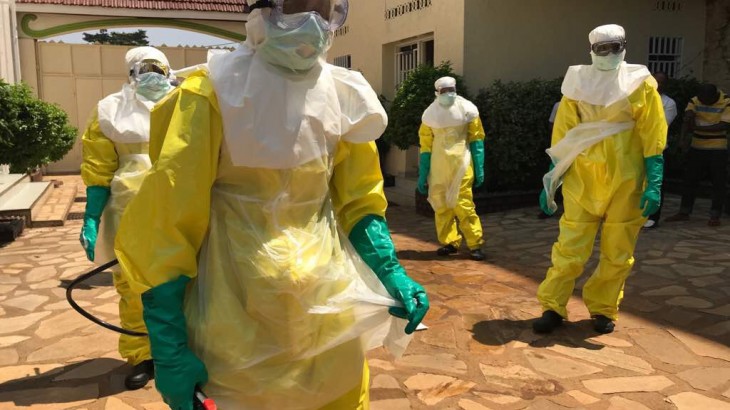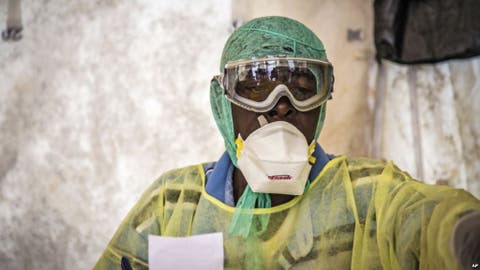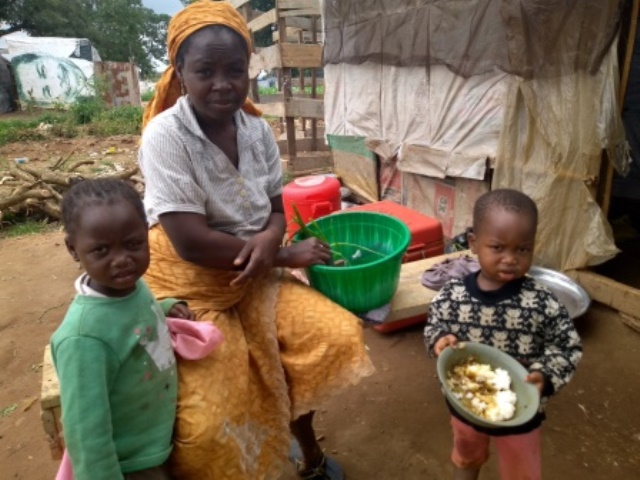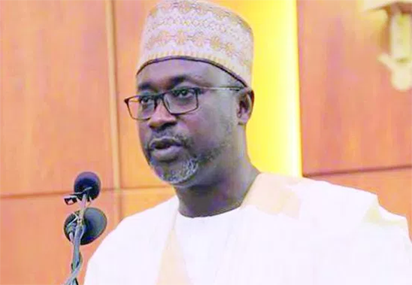POLICY GUIDELINES ON
SOLID WASTE MANAGEMENT
DEVELOPED BY
FEDERAL MINISTRY OF ENVIRONMENT
ABUJA
JULY 2005
PREFACE
Solid Waste Management remains one of the most daunting Environmental Sanitation challenges facing the country today and it has continually remained at its lowest ebb despite huge investments in the sector. Currently, as a result of industrialisation and rapid population growth in many cities and towns, wastes are generated faster than they are collected, transported and disposed.
The National Environmental Sanitation Policy sets out to achieve a clean and healthy environment for all Nigerians. In tackling the underlying problems of solid waste management, this Policy Guidelines has recommended effective, efficient and sustainable waste management strategies. Such strategies include, waste minimisation at source through re-use, recycle and energy recovery before final disposal. Due emphasis has also been given to the use of locally available, appropriate and easily affordable technologies. Criteria for standardisation of the technologies have also been put in place.
Furthermore, since the type and volume of waste generated vary with location and season of the year, the preferred waste management options also vary from place to place and season to season. Thus, the methods of solid waste management have been hinged on the diverse socio-cultural, religious and topographical considerations that exist in the country.
The roles expected of all Stakeholders are clearly spelt out in the Policy Guidelines with special emphasis on the role of the private sector for their full participation. A clear call for adequate funding of the various strategies has been made to all Stakeholders. Sanctions and enforcement mechanisms shall be strengthened and decentralised for better efficiency while rewards for best practices shall be institutionalised.
The ultimate aim of the Policy Guidelines is to ensure that solid waste management is private sector driven with a potential to create employment and wealth. This no doubt shall enhance sustainability.
Col. Bala Mande (rtd.)
Honourable Minister of Environment.
July 2004
1.0 INTRODUCTION
1.1 The growth of human population coupled with increased economic activities in towns and cities result in high rate of solid waste generation. A fundamental attribute of solid waste is that it is inevitable as almost every human activity involves the generation of waste in solid, liquid and gaseous forms. Social dynamics such as modernisation and economic development influence waste generation. This calls for careful planning and adequate resource allocation to forestall a mismatch between the rates of waste generation, rate of collection and disposal.
1.2 The management of solid waste is far from being satisfactory in Nigeria. Many parts of our cities and towns do not benefit from any organised waste management services and therefore wastes are unattended to, buried, burnt or disposed haphazardly. In areas where the authorities do the collection, it is often irregular and sporadic. Recycling of waste is negligible while the methods used for collection, transportation and final disposal are very unsatisfactory. Waste when left unattended for a long time constitutes serious health hazard, causes offensive odour, pollutes underground water sources and decreases environmental aesthetics and quality.
1.3 The waste burden has indeed become critical with waste products often containing materials that are toxic and not readily biodegradable. Such materials include various types of industrial chemical wastes, which can contaminate soil and underground water sources indefinitely if not properly disposed. Biomedical wastes from health care institutions also contain infectious/hazardous materials that can pose potential hazards to the environment and human health, when not properly disposed. The improper handling and disposal of medical wastes is a major threat to refuse collectors and scavengers and can result in infections such as HIV/AIDS, Tetanus, Hepatitis, etc. This in turn undermines productivity and reduces national income, thereby perpetuating a vicious cycle of poverty.
1.4 Effective and efficient Solid Waste Management is based on a hierarchy of management options: the reduction of waste, its reuse wherever possible, recycling, composting and energy recovery, and final disposal. However, there will always be certain wastes for which incineration is the most reasonable environmental and economic option. The Government policy shall seek to choose the best options for waste management that will minimise the risk of environmental pollution and harm to human health.
2.0 AIM
To improve and safeguard public health and welfare through efficient sanitary Solid Waste Management methods that will be economical, sustainable and guarantee sound environmental quality.
3.0 OBJECTIVES
3.1 To develop Policy Guidelines for efficient and sustainable Solid Waste Management in Nigeria.
3.2 To promote a healthy environment by ensuring sanitary Solid Waste Management.
3.3 To minimize waste generation and promote sorting at source, reuse, recycling and energy recovery.
3.4 To ensure safe and nuisance-free disposal of (urban and rural) domestic, medical, and industrial wastes in order to adequately protect public health during and after collection, transportation, treatment and final disposal.
3.5 To promote effective Stakeholders participation in Solid Waste Management.
3.6 To generate employment opportunities, improve the standard of living and thus reduce poverty.
3.7 To optimize labour and equipment in waste management to enhance increased productivity.
3.8 To facilitate cost recovery in waste management investment and ensure project replication and sustainability.
3.9 To build an institutional framework capable of ensuring an efficient waste management system.
3.10 To evolve and maintain an indigenous waste management system based on the physical and socio-cultural characteristics of communities.
3.11 To maintain adequate and regular waste management services at affordable cost.
4.0 JUSTIFICATION
4.1 The alarming rate at which heaps of solid wastes occupy most of our cities, coupled with the fact that 87% of Nigerians use methods adjudged as insanitary, has not only constituted visual blight and odour nuisance, but also encouraged the breeding of rodents, mosquitoes and other pests of public health importance with their attendant disease outbreaks.
4.2 It is common knowledge that markets and motor parks used by hundreds of Nigerians daily are seldom provided with facilities used for solid waste collection and disposal. As a result of this men and women in markets and motor parks often result into indiscriminate disposal of solid waste into public drains, around street corners, etc.
4.3 Flooding on our major roads is due largely to silt and solid waste blocking the drains and other outlets provided. The stagnant water in the blocked drains serve as breeding sites for mosquitoes.
4.4 The high incidence of improper waste management related diseases, e.g cholera, typhoid, diarrhoea, malaria etc, have become a source of embarrassment to Government. It is a known fact that a dirty environment with its attendant health consequences that prevails in most of our cities could scare away tourists and investors.
4.5 The World Health Organization (WHO) is also concerned about poor sanitation in member countries. In a resolution by the Regional Committee for Africa during the Forty-third session stated in its document AFR/RC43/R2 of 7th September 1993, that it is expedient to affirm that proper sanitation and sound waste management are crucial in the promotion and protection of human health and of the environment, both of which are necessary for sustainable development.
5.0 STRATEGIES
5.1 Promote waste minimization at household and community levels, through reduction at source, reuse, recycling and resource recovery.
5.2 Evolve and promote appropriate technologies for recycling of waste components such as bottles, glass, metals, paper, plastic and organic matter.
5.3 Foster the establishment of small-scale waste recycling plants at household and community levels, to source for and convert recyclable waste.
5.4 Develop technical capacity of public and private sector agencies in Solid Waste Management.
5.5 Conduct research to determine per capita waste generation and build a database on Solid Waste Management.
5.6 Establish regulations, sanctions and enforcement mechanisms for Solid Waste Management from source of generation to the point of disposal.
5.7 Develop a Solid Waste Master Plan as a national blue print for effective Solid Waste Management.
5.8 Evolve realistic and sustainable funding mechanisms.
5.9 Create public awareness and sensitisation on efficient municipal Solid Waste Management practices.
5.10 Ensure effective monitoring and evaluation of municipal Solid Waste Management practices
5.11 Set health criteria for manual sorting of wastes at household and community levels
6.0 INSTITUTIONAL ROLES
6.1 The Federal Government shall:
6.1.1 Develop, periodically review and update the Policy Guidelines on Solid Waste Management.
6.1.2 Develop and circulate set standards for equipment procurement and maintenance in Solid Waste Management.
6.1.3 Develop and circulate set standards on private sector participation in Solid Waste Management services
6.1.4 Prepare a Solid Waste Master Plan as a national blue print for effective Solid Waste Management and ensure its implementation at the appropriate levels of Government.
6.1.5 Enact appropriate Legislation that will foster successful implementation of the Policy Guidelines and Master Plan.
6.1.6 Source for funds for programme development, specialized studies and capacity building on Solid Waste Management.
6.1.7 Provide technical assistance to States and LGAs in Solid Waste Management.
6.1.8 Initiate relevant programmes for improved Solid Waste Management practises
6.1.9 Establish a national data bank on Solid Waste Management for planning and development.
6.1.10 Provide environmental education and awareness on sound Solid Waste Management.
6.1.11 Collaborate with relevant Stakeholders and ESAs on Solid Waste Management
6.1.12 Register Solid Waste Management facilities that require EIA certification
6.2 The State Government shall:
6.2.1 Support and ensure the implementation of the Policy Guidelines on Solid Waste Management.
6.2.2 Facilitate the implementation of the National Solid Waste Master Plan
6.2.3 Enact relevant State Legislation
6.2.4 Provide technical support to the LGAs through training and manpower development programmes for capacity building and institutional strengthening.
6.2.5 Support the provision of logistics including financial instruments to facilitate private sector participation in Solid Waste Management.
6.2.6 Conduct public education and enlightenment on sound Solid Waste Management.
6.2.7 Conduct research into local options for Solid Waste Management to guide LGAs.
6.2.8 Establish data bank on Solid Waste Management.
6.2.9 Provide land for siting waste management facilities.
6.3 Local Government shall:
6.3.1 Implement the Policy Guidelines on Solid Waste Management as a statutory obligation.
6.3.2 Implement the National Solid Waste Master Plan.
6.3.3 Enact appropriate legislative instruments and establish necessary sanctions and enforcement mechanisms for efficient service delivery.
6.3.4 Enlist the services of the private sector and other Stakeholders in Solid Waste Management.
6.3.5 Register and license all operators of waste management facilities and services.
6.3.6 Make adequate annual budgetary provisions for Solid Waste Management
6.3.7 Recruit, train and retrain staff for efficient service delivery.
6.3.8 Establish a consultative forum with members of the public to build consensus on appropriate strategies for waste management.
6.3.9 Develop IEC materials on solid waste handling techniques at household level
6.3.10 Promote private sector participation in the delivery of waste management options.
6.4 The Private Sector shall:
6.4.1 Comply with the provisions of the National Policy Guidelines and Master Plan on Solid Waste Management.
6.4.2 Participate in Solid Waste Management on cost recovery basis.
6.4.3 Undertake waste recycling activities in an environmentally sound manner.
6.4.4 Engage in partnership with Local Governments for better service delivery.
6.4.5 Undertake research, specialized studies and product development in Solid Waste Management.
6.4.6 Promote public enlightenment campaigns.
6.5 Civil Society Organisations shall:
6.5.1 Undertake grassroots mobilization to support appropriate waste management options.
6.5.2 Promote the adoption of waste separation and resource recovery at household level.
6.5.3 Promote public enlightenment campaigns on appropriate strategies for waste storage, collection and disposal.
6.6 The Public shall:
6.6.1 Adopt environment friendly habits and practices.
6.6.2 Comply with existing Legislation on Solid Waste Management.
6.6.3 Comply with the provisions of the Policy Guidelines
6.6.4 Cooperate with other Stakeholders to ensure sustainable Solid Waste Management systems.
6.6.5 Patronise recycled goods and biodegradable packages.
6.6.6 Undertake sorting of recyclable components at source and dispose residue at designated sites.
6.6.7 Segregate hazardous wastes and ensure hygienic and safe disposal.
6.6.8 Maintain sanitary dustbins in homes
6.6.9 Adopt the technology of converting local waste into energy generation including biogas.
6.6.10 Adopt the use of compost as soil conditioner.
6.6.11 Pay for Solid Waste Management services to ensure its sustainability.
7.0 GUIDELINES FOR EFFICIENT SOLID WASTE MANAGEMENT SERVICE DELIVERY AT THE LOCAL GOVERNMENT LEVEL
The strategies adopted for waste management at the Local Government level shall relate to the culture, land use types, economic base, climatic conditions, level of urbanization and the existing institutional arrangement. However, the following guidelines are provided as a broad statement to make for strategic interventions in Solid Waste Management in Nigeria.
7.1 WASTE STORAGE
7.1.1 Household sanitary dustbins or disposable refuse bags for collection and storage of household wastes shall be promoted. The sanitary dustbins either galvanized or plastic of about 20kg capacity shall be fitted with two handles and a well fitting cover to prevent fly infestation and odour nuisance. The bins shall be kept out of reach of domestic animals, to prevent spillage of refuse. The galvanized dustbin shall be kept in a non-moist area to prevent corrosion. The dustbins shall be emptied into designated solid waste depot located within the area. Appropriate colour codes shall be adopted for segregation or sorting of domestic and hazardous wastes.
7.1.2 For commercial areas e.g. Market, etc, mammoth bins shall be placed at strategic locations to accommodate the large volume of solid waste generated at the market place.
7.1.3 For industrial premises dinosaur bins of about 1500kg should be placed at strategic locations within such premises to retain solid wastes generated.
7.2 WASTE COLLECTION
The Local Government shall:
7.2.1 Conduct studies and classify all settlements according to their level of urbanization, size, function and economic base into urban, semi-urban and rural.
7.2.2 Review existing collection equipment, method, and frequencies, as well as the tradition and labour practices.
7.2.3 Determine the most efficient system of waste collection for each settlement category and:
i. Set out the method of refuse pick,
ii. Determine manpower and equipment needs,
iii. Determine vehicle type and routing system.
7.2.4 Integrate as much as possible, the various waste collection methods adopted for the different levels of settlements.
7.2.5 Introduce standardized waste storage bins but where this is not immediately possible, existing storage bins shall be made functional and safe.
7.2.6 Implement collection methods that take into account differences in residential districts of a city as indicated below:
Residential Area Collection method
Well planned, high income, low density areas House to house
Medium density residential layouts Kerb side
High density low income districts Communal depots
In case of communal depots, adequate numbers shall be provided within 200 to 250 meters walking distance to residences.
7.2.7 Set up an efficient system for sanctioning and enforcement.
7.2.8 Monitor, evaluate and re-plan at regular intervals
7.3 COLLECTION EQUIPMENT
7.3.1 In the choice of waste collection vehicles and equipment, emphasis shall be on optimizing vehicle and labour for improved productivity. The following guidelines are offered for vehicle choice:
i. A variety of non-motorised vehicles, which are human or animal powered are the most appropriate to be used as primary refuse collection vehicles in areas inaccessible to motor vehicles, such as in high density areas with poor road access; or when haul distance is short. Examples of such vehicles include:
a) Handcarts – with container capacity of about 200kg have economic radius of operation of about 1km.
b) Pedal tricycles – with container capacity up to 500kg, have economic operation radius of about 2-3 km.
c) Animal drawn carts – have limited capacity of about 2 cubic meter, with an economic radius of operation of about 3km.
ii. In densely populated areas, heavy motorized vehicles often create problems. In such circumstances and particularly where haul distance is long, the collected intra settlement wastes can be transferred from a small vehicle to a large one at the periphery of settlements or at an appropriate location created as transfer station.
iii. The compactor truck is uneconomical and inappropriate in most areas because non-compaction vehicles can adequately collect our type of waste.
7.3.2 The choice of solid waste handling machine and equipment shall comply with the set guidelines of the Federal Government
7.3.3 The programme of equipment procurement shall be accompanied by maintenance agreement.
7.4 TRANSFER STATIONS
7.4.1 The need for transfer stations has been recognized particularly for some large metropolitan centers. Transfer stations shall be established where any of the following conditions subsist:
i. Where disposal sites cannot be located near the sources of solid waste generation.
ii. Where the responsibilities for waste mangement are separated and in the hands of different agencies.
iii. Where labour and transportation costs are high, particularly for haulage business.
7.4.2 Transfer station shall be built where public objection to its construction is limited and transport cost is optimized.
7.5 WASTE TRANSPORTATION
Intra-city and inter-city transportation of solid waste shall comply with the following guidelines:
7.5.1 Choice of vehicles shall comply with set guidelines on equipment procurement.
13
7.5.2 Transport vehicles shall be covered to prevent unhealthy spread and dispersal of waste.
7.5.3 Transport itinerary shall be planned and properly routed in a manner that will not encumber intra-city mobility.
7.6 WASTE MANAGEMENT METHODS
7.6.1 Sanitary landfill remains the most cost-effective means of Solid Waste Management. Local Governments shall identify suitable landfill sites. The management of the site shall be public or private but the LGA shall monitor and supervise the sites to ensure compliance with standards.
7.6.2 The biological decomposition of organic wastes to produce biogas and/or compost shall be encouraged.
7.6.3 The large potential for recycling that has been found for municipal waste in Nigeria shall be tapped.
7.6.4 Incineration as a method of waste treatment shall be employed only where the local environment permits and for selected wastes.
7.7 MANAGEMENT OPTIONS
7.7.1 Four (4) management options are recommended:
i. By Local Government/Municipal Agencies;
ii. By Private Companies on contract with the LGA/Municipality;
iii. By Private Companies on contract with Home Owners.
iv. By public/private partnership
7.7.2 Direct operations of waste management by LGA/Municipal Agencies may be embarked upon where the private initiative is low. This practice is often bedeviled with frequent personnel turnover and the use of incompetent or untrained officials. Although money may be saved, it may be at the expense of satisfactory performance.
7.7.3 Contracting out waste collection to private contractors by the LGA/ Municipal Agency has its advantages. First, waste collection is conducted as a business venture without political considerations. Similarly, the burden of expenditure for equipment and capital outlay is placed on private companies while collection is effective. However, it may sometimes be counter-productive, as profit is the object of service. Also, contractual obligations are fixed and inflexible to changing conditions, as alterations in collection practices will require review in terms of contract. Furthermore, there are dual risks. One occurs in case of non-renewal of contract in spite of high capital outlay by the private contractor. The other is the risk to Government in case the private contractor fails.
7.7.4 Contract with individual house-owners is a frequent occurrence in sub-urban or rural areas where the LGA/Municipality does not usually render waste collection services. The practice has been found to be highly competitive and often uneconomic. There is usually price cutting by operators, which leads to low service standard. However, if properly organized and well monitored by the LGA, the service can be very effective in ridding the city of waste.
7.7.5 Public private partnership which is the latest practice the world over, shall be encouraged as this service will without doubt complement the efforts of the Government at getting rid of solid waste heaps in the city. Apart from the fact that the system will create more employment and alleviate poverty of the operators, the revenue base of the LGA will be significantly increased through the registration and licensing of such operators. However, the Government on its part shall promote and organize this sector through creation of appropriate enabling environment.
7.8 PRIVATE SECTOR PARTICIPATION
Private sector participation shall be hinged on the principle of fair play and transparency that is devoid of political undertones. The selection of private sector participants in Solid Waste Management shall be organised as follows:
7.8.1 Franchised area shall be planned and mapped.
7.8.2 Criteria for company qualification and selection shall be clearly stated.
7.83 Indicators for franchised performance shall be specified.
7.8.4 Terms of Reference and Conditions of Engagement of the private sector participant shall be well defined.
7.8.5 Monitoring and evaluation procedures shall be outlined.
7.8.6 Entire operations shall be backed by Legislation.
7.9 SANCTIONS AND ENFORCEMENT MECHANISMS
Mobile Sanitation Courts have become necessary to encourage public compliance with set rules and regulations, enforce standards and ensure positive attitudinal changes. In this regard, the following shall be put in place:
7.9.1 Bye-laws on Solid Waste Management stipulating service standards and operations as well as citizen’s obligations, shall be enacted.
15
7.9.2 The Bye-laws shall be adequately disseminated to all communities.
7.9.3 Local and mobile courts shall be established where they do not exist, to try offenders and impose sanctions.
7.9.4 Sanctions shall be strictly enforced.
7.10 REWARD FOR BEST PRACTICES
7.10.1 Each tier of Government shall identify best practices based on set criteria for exposition and reward.
7.10.2 Replication of best practices shall be encouraged.














